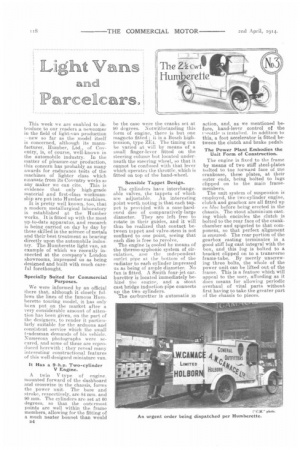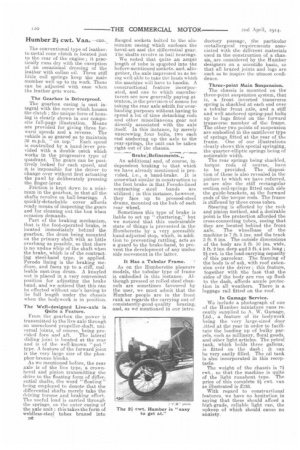rPht V &net
Page 16

Page 18

If you've noticed an error in this article please click here to report it so we can fix it.
ParceRcmrsi
This week we are enabled to introduce to our readers a newcomer in the field of light-van production —new so far as the model itself is concerned, although its manufacturer, Humber, Ltd., of Coventry, is, of course, well-known in the automobile industry. In the matter of pleasure-ear production, this concern has probably as many awards for endurance tests of the machines of lighter class which emanate from its Coventry works as any maker we can cite. This is evidence that only high-grade material and first-class workmanship are put into Humber machines.
It is pretty well known, too, that a modern metallurgical laboratory is established at the Humber works. It is fitted up with the most up-to-date apparatus, and research is being carried on day by day by those skilled in the science of metals and their best treatment as bearing directly upon the automobile industry. The Humberette light van, an example of which we recently insnected at the company's London showrooms, impressed us as being designed and built with much careful forethought, Specially Suited for Commercial Purposes.
We were informed by an official there that, although it closely follows the lines of the famous Humherette touring model, it has only been put on the market after a very considerable amount of attention has been given, on the part of the designers, to render it particularly suitable for the arduous and consistent service which the small tradesman demands of his vehicle. Numerous photographs were secured, and some of these are reproduced herewith ; they reveal many interesting eonstruetional features of this well-designed miniature van.
It Has a 9-h.p. Two-cylinder V Engine.
A twin V type of engine. mounted forward of the dashboard and crosswise in the chassis, forms the power unit. The bore and stroke, respectively, are 84 mm. and 90 mm. The cylinders are set at 60 degrees, so that the outermost points are well within the frame members, allowing for the fitting of a much neater bonnet than would
D4 be the case were the cranks set at 90 degrees. Notwithstanding this form of engine, there is but one magneto fitted ; it is a Bosch hightension, type ZE4. The timing can be varied at will by means of a small finger-lever fitted on the steering column but located underneath the steering wheel, so that it cannot be confused with that lever which operates the throttle, which is fitted on top of the hand-wheel.
Sensible Tappet Design.
The cylinders have interchangeable valves, the tappets of which are adjustable. An interesting point worth noting is that each tappet is provided with a case-hardened disc of comparatively-large diameter. They are left free to rotate in their guides, and it will thus be realized that contact between tappet and valve-stein is not tonfined to one point, seeing that each disc is free to yevolve.
The engine is cooled by means of the thcrmo-syphonic system of circulation, ano the independent outlet pipe at the bottom of the radiator to each cylinder impressed us as being of ample diameter. No fan is fitted. A Smith four-jet carburetter is located immediately behind the em,rinP, and a stout cast bridge induction-pipe connects up the two cylinders.
The carburetter is automatic An action, and, as we mentioned before, hand-lever control of the virottle is installed. In addition to this, a foot accelerator is fitted between the clutch and brake pedals
The Power Plant Embodies the Unit Form of Construction.
The engine is fixed to the frame by means of two stiff steel-plates bolted to tne forward face of the crankcase, these plates, at their outer ends, being bolted to lugs clipped on to the main framemembers.
The unit system of suspension is employed, the two-cylinder engine, clutch and gearbox are all fitted up en bloc before being erected in the chassis. The stout aluminium casting which encircles the clutch is bolted to the rear face of the crankchamber and spigoted to that component, so that perfect alignment is ensured. The rear portion of the gearbox casting terminates in a good stiff lug cast integral with the box, and this lug is bolted to a bracket clipped on to a transverse frame-tube. By merely unscrewing three bolts, the whole of the power unit can be lifted out of the frame. This is a feature which will appeal to the user, affording as it does means for allowing periodic overhaul of vital parts without first having to take the greater part of the chassis to pieces.
The conventional type of leatherto-metal cone clutch is located just to the rear of the engine ; it practically runs dry with the exception of an occasional dressing of the leather with collan oil. Three stiff little coil springs keep the male member well up to its work. These can be adjusted with ease when the leather gets worn.
The Gearbox is Driverprool.
The gearbox casing is cast integral with the cover which houses the clutch ; the unique form of housing is clearly shown in our composite full-page illustration. Means are provided for giving three forward speeds and a reverse. The vehicle is so geared as to maintain 30 m.p.h. " on top." Each speed is controlled by a hand-lever provided with a double catch which works in the progressive type of quadrant. The gears can be positively locked for each speed, and it is impossible for the driver to change over without first actuating the pawl by deliberately pressing the finger-lever.
Friction is kept down to a minimum in the gearbox, in that all the shafts revolve on ball-bearings. A quickly-detachable cover affords ready means of inspecting the gears and for cleaning out the box when occasion demands.
Part of the braking mechanism, that is the foot-operated brake' is located immediately behind the gearbox, the drum being mounted on the primary shaft with as little overhang as possible, so that there is no undue whip of the shaft when the brake, which is of the contracting steel-hand type, is applied. Ferodo lining is the braking medium, and faces up to a stiff, malleable cast-iron drum. A knurled nut is placed in a very convenient position for adjusting the brake band, and we noticed that this can be effected without one's having to lie full length under the chassis when the bodywork is in position.
The Well-designed Live-axle is Quite a Feature.
From the gearbox the power is transmitted to the live-axle through an uneuclosed propeller-shaft, universal joints, of course, being provided fore and aft. The lateral sliding joint is located at the rear and is of the well-known " pot " type, A feature of the forward joint is the very large size of the phosphor-bronze blocks.
As we mentioned before, the rear axle is of the live type, a crownbevel and pinion transmitting the drive to the floating form of differential shafts, the word "floating" being employed to denote that the differential shafts merely take the driving torque and braking effort. The useful load is carried through the springs. on the outer casing of the axle unit ; thia takesthe form of weIdless-steel tubes brazed into
ng hanged sockets bolted to the aluinirnum casing which encloses the bevel-set and the differential gear. The shafts revolve in ball bearings.
We noted that quite an ample length of tube is spigoted into the before-mentioned sockets. and. altogether, the axle impressed us as being well able to take the loads which the machine will have to handle. A constructional feature incorporated, and one to which manufacturers are now generally paying at tention, is the provision of means for taking the rear axle adrift for overhauling purposes without having to spend a lot of time detaching rods and other miscellaneous gear not directly associated with the axle itself. In this instance, by merely unscrewing four bolts, two each end anchoring up the axle to the rear-springs, the unit can be taken right out of the chassis.
Brakeillefinements.;, An additional and, of course, independent braking to that which we have already mentioned is provided, i.e., a hand-brake. It is somewhat similar in construction to the foot brake in that Ferodo-lined
contracting steel bands are utilized ; in this instance, however they face up to pressed-steel drums, mounted on the hub of each rear wheel.
Sometimes this type of brake is liable to set up "chattering," but we noticed that this undesirable state of things is prevented in the Humberette by a very accessible hand-adjusted stop, which, in addition to preventing rattling, acts as a guard to the brake-band, to prevent the development of any undue side movement in the latter.
It Has a Tubular Frame. 7
As on the Humberette pleasure models, the tubular type of frame is embodied in this instance. Although pressed or rolled-steel channels are sometimes favoured by the user, we must admit that the Humber people are in the front rank as regards the carrying out of consistently-good-quality brazing, and, as we mentioned in our intro ductory passage, the particular metallurgical requirements associated with the different .materials used in the construction of a chassis, are considered by the Humber designers on a scientific basis, so that all brazed joints and lugs are such as to inspire the utmost confidence.
Three-point Main Suspension, The chassis is mounted on the three-point suspension system, that is, a front inverted transverse spring is shackled at each end over a tubular front axle, and a stiff and well anchored spring-pad bolts up to lugs fitted on the forward transverse member of the frame. The other two points of suspension are embodied in the cantilever type of springs fitted at the rear of the frame. One of our illustrations clearly shows this special springing, the quarter-elliptic springs being of noticeable width.
The rear springs being shackled, torque rods of course, have to be provided. The disposition of these is also revealed in the picture to which we have referred, as are also the stiff rectangular section coil-springs fitted each side the guide-brackets, at the forward ends of the torque rods. The frame is stiffened by three cross tubes.
Steering is effected by the rack and pinion method, and a desirable point is the protection afforded the cross-connecting tubes, seeing that they are located behind the front axle. The wheelbase of the machine is 7 ft. 5 ins, and the track 3 ft. 6 ins. The outside dimensions of the body are 3 ft10 ins. wide, 3 ft. 2 ins, deep and 3 ft. 4 ins. long ; 2icwt. is the load-carrying capacity of this parcelcar. The framing of the body is of ash, with roof extension over the driver ; this feature, together with the fact that the sides of the body are run up flush to the dash, affords ample protection in all weathers. There is a luggage rail fitted on the roof.
In Gamage Service.
We include a photograph of one of the Humber miniature vans recently supplied to A. W. Gamage, Ltd., a feature of its bodywork being the very large-sized door ,itted at the rear in order to facilitate the loading up of bulky parcels, such as millinery, floral goods, and other light articles. The petrol tank, which holds three gallons, is fitted on the dash ; it can be very easily filled. The oil tank is also incorporated in this receptacle The weight of the chassis is 7i cwt., so that the machine is quite of the light runabout type. The price of this complete 2i cwt. van as illustrated is £135.
With regard to constructional features, we have no hesitation in saying that these should afford a high-grade, reliable light van, the upkeep of which should cause no anxiety.






















